Thursday, September 18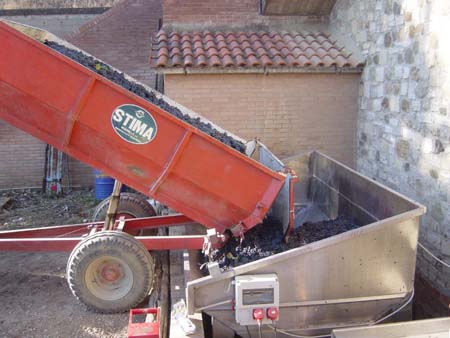
Paula: Another cloudless day in Tuscany! This turned
out to be our day to learn more about the food and wine of Tuscany. The grape
harvest is in full swing and we have had fun watching the workers on our estate
cut the grapes from the vines - last week white and this week red. Today we
camped out near the area where they process the grapes and begin the wine
production. Our patience was 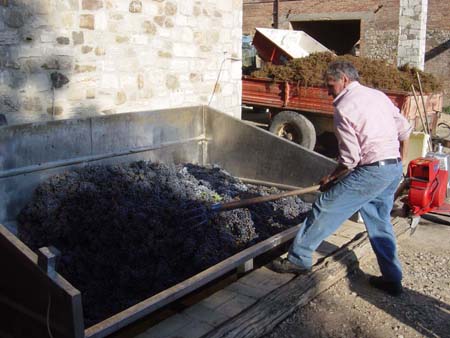 rewarded
late in the afternoon when two large tractors overflowing with red grapes
rolled into the barnyard. The workers allowed us to watch them unload the
grapes into a machine which removed the stems, pressed the grapes, and pumped
the juices and skins into huge fermentation and storage containers. We stood
fascinated watching the large loads of grapes being dumped into the separator,
pressed and pumped inside into the tanks. Bees were swarming all around, and
the
rewarded
late in the afternoon when two large tractors overflowing with red grapes
rolled into the barnyard. The workers allowed us to watch them unload the
grapes into a machine which removed the stems, pressed the grapes, and pumped
the juices and skins into huge fermentation and storage containers. We stood
fascinated watching the large loads of grapes being dumped into the separator,
pressed and pumped inside into the tanks. Bees were swarming all around, and
the 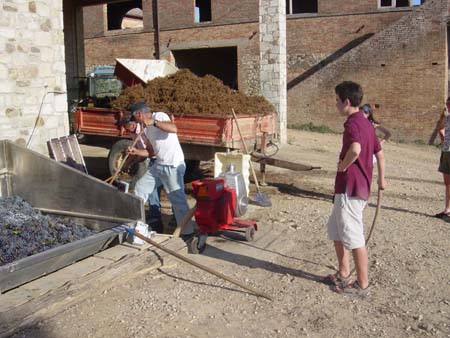 smells
of the grape juice were overpowering. We then moved inside to watch the huge
fermentation and storage tanks being filled with the freshly pressed grapes.
The gentleman supervising the process soon took an interest in our curiosity
and was happy to explain to us what was happening. We soon learned that Lamberto
was actually one of the owners of the estate, and is responsible for managing
the entire wine
smells
of the grape juice were overpowering. We then moved inside to watch the huge
fermentation and storage tanks being filled with the freshly pressed grapes.
The gentleman supervising the process soon took an interest in our curiosity
and was happy to explain to us what was happening. We soon learned that Lamberto
was actually one of the owners of the estate, and is responsible for managing
the entire wine 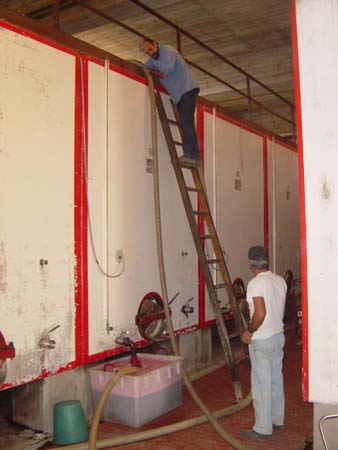 production
process.
production
process.
Lamberto gave us a great (and totally unexpected) private lesson on the whole
wine making process. He started by explaining exactly what was happening both
with the grapes that had just been harvested, and with the juices that were
in the process of fermenting. For the grapes coming in today, the grapes were
being pressed and pumped directly into the fermentation tanks. For red grapes,
this is done with the skins and seeds mixed with the juice - this is how the
red wine gets its color. Eventually the 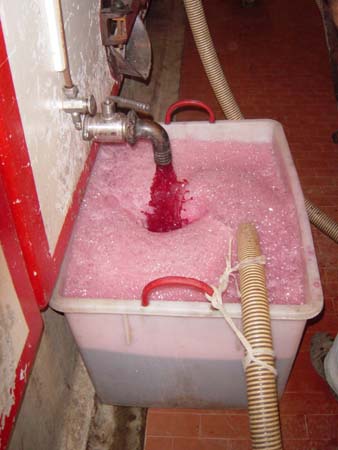 skins
will be removed and pressed separately, and used by a distillery to make grappa.
The sediments from the bottom of the tanks will also be processed and used
for non-consumed products such as rubbing alcohol. Lamberto was also supervising
a process where the juice that was harvested two days ago was being mixed
and circulated. This was done using a pump and large tubes - the juice was
removed from the bottom and pumped back into the top. This is done frequently
and necessary so that the skin is distributed as evenly as possible throughout
the juice.
skins
will be removed and pressed separately, and used by a distillery to make grappa.
The sediments from the bottom of the tanks will also be processed and used
for non-consumed products such as rubbing alcohol. Lamberto was also supervising
a process where the juice that was harvested two days ago was being mixed
and circulated. This was done using a pump and large tubes - the juice was
removed from the bottom and pumped back into the top. This is done frequently
and necessary so that the skin is distributed as evenly as possible throughout
the juice. 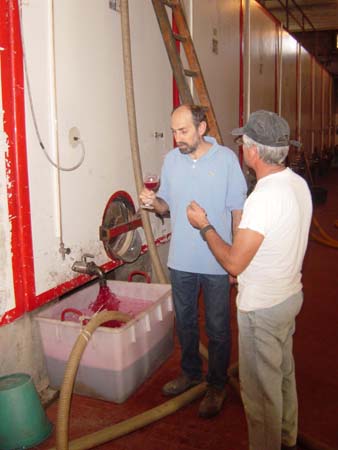
Lamberto showed us how the juice is periodically checked for temperature
and alcohol content, and took samples of the grape juice collected several
days ago to show us how it compared to the grape juice just coming in. Fermentation
had already begun on grapes collected two days ago (we could see the bubbles
and also the darker color as compared to today's juices), and is proceeding
nicely - based on the progress so far, Lamberto is predicting that the alcohol
content for this year's wine will be up around 13%, which is very high and
signifies a good quality grape. Lamberto explained that the fermentation will
take about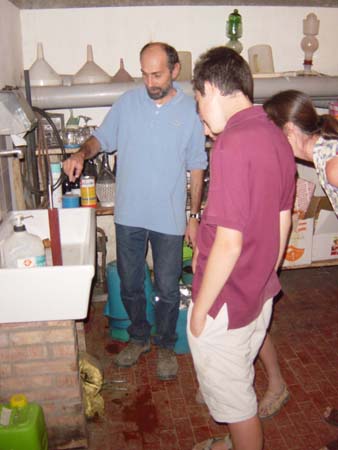 15 days, and that the wine will be stored here until February or March until
it's sold. No bottling is done here on site - the owners sell their wine to
the producer that makes Ruffino Chianti. Ruffino uses vineyards such as this
one to supplement its own production - they don't have enough of their own
vines. We actually recognize the Ruffino name as a wine that we can buy at
home.
15 days, and that the wine will be stored here until February or March until
it's sold. No bottling is done here on site - the owners sell their wine to
the producer that makes Ruffino Chianti. Ruffino uses vineyards such as this
one to supplement its own production - they don't have enough of their own
vines. We actually recognize the Ruffino name as a wine that we can buy at
home.
Lamberto tasted and examined the juices from the tanks in order to monitor
how the process is going. He explained that the wine making is very much an
art, and that several things can go wrong along the way. It was fascinating
to hear Lamberto describe all the elements involved, and the need to continually
monitor the process. Tomorrow, the people from Ruffino are coming for an inspection.
Ruffino actually provides ongoing instruction to Lamberto and his people so
that the wine produced here is as similar as possible to the wine which Ruffino
produces with its own vineyards. It is a real treat to be in Tuscany during
the harvest and we feel so fortunate to have experienced and witnessed the
process in person and in such detail.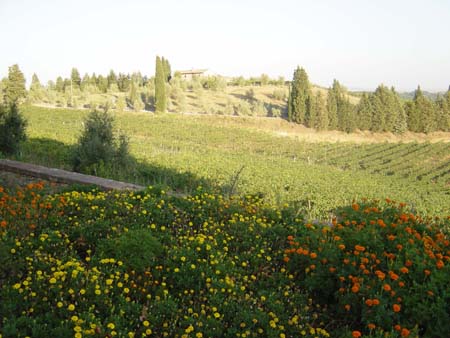
After the lesson in winemaking, Lamberto offered to show us the estate's
gardens. We had heard that the gardens were extensive, but were not able to
see them because the area is closed due to the ongoing restoration of the
main farmhouse. The gardens are magnificent! They slope down from the main
house and lead to a huge open patio overlooking the Tuscan countryside. The
gardens include an "orangerie" with several types of citrus trees,
some 50 years old. There is a large pond with lily pads, an aviary with parakeets
and doves as well as a large greenhouse 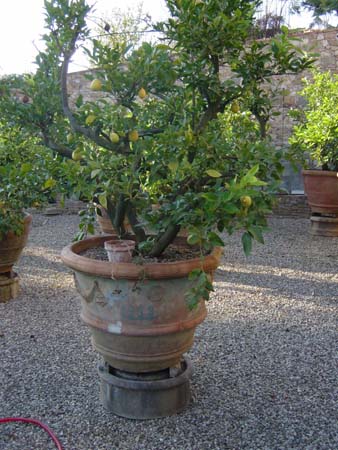 (established
in 1881) filled with exotic plants. We also talked with Lamberto about the
restoration of the estate which he hopes will be complete in about two more
years. The main farmhouse will include more apartments and a restaurant. It
was originally built in neoclassical style and has a lovely exterior. A steeple
is visible and Lamberto indicated the house had a small chapel. Lamberto explained
that the restoration of the farmhouse where we're staying, plus two others,
was completed five years ago - they have now moved into the larger and more
challenging portion of the project, but expect great rewards. Interestingly,
he also told us that our farmhouse was built originally in 1200. The more
we learn about Tenuta di Monaciano, the more we love it. A return stay here
is now a necessity!
(established
in 1881) filled with exotic plants. We also talked with Lamberto about the
restoration of the estate which he hopes will be complete in about two more
years. The main farmhouse will include more apartments and a restaurant. It
was originally built in neoclassical style and has a lovely exterior. A steeple
is visible and Lamberto indicated the house had a small chapel. Lamberto explained
that the restoration of the farmhouse where we're staying, plus two others,
was completed five years ago - they have now moved into the larger and more
challenging portion of the project, but expect great rewards. Interestingly,
he also told us that our farmhouse was built originally in 1200. The more
we learn about Tenuta di Monaciano, the more we love it. A return stay here
is now a necessity! 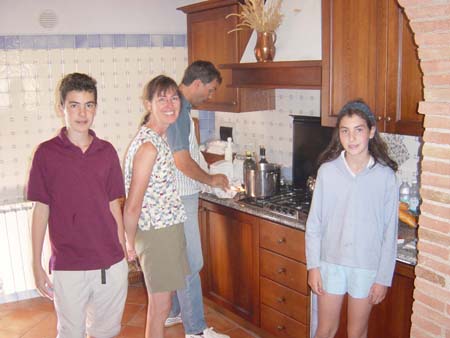
We also enjoyed a cooking lesson today from Francesco. Francesco is the husband
of Fiora, who is one of the office managers here at Tenuta di Monaciano. Francesco
is also a veterinarian here in Tuscany, and primarily cares for horses. When
we asked about hiring someone to give us a Tuscan cooking lesson, we were
told that Francesco is a wonderful cook and that he could prepare us a meal
right in our kitchen - this sounded great. Francesco arrived with ingredients
and food processor in hand at about 11:00 this morning. Over the next several
hours Francesco shared with us the secrets passed on to him by his mother
and grandmother. We learned that to make a good sauce you must make an excellent
sofrito (a sautéed vegetable base for the sauce). Francesco said that
this is absolutely the most important 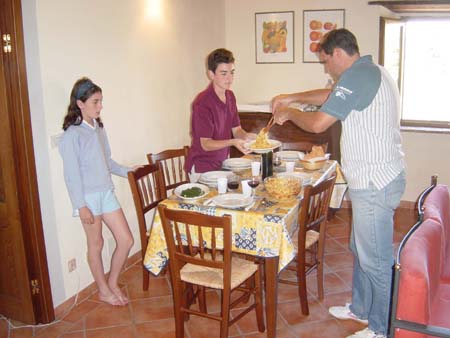 element
of making a great sauce, and responsible for 70% of its flavor! He also shared
with us his method of making pomodoro sauce. One thing that surprised us were
the amount of salt used-both in the sauce and the water for boiling pasta.
We aren't talking teaspoons here but as much as 1/3 cup! For lunch Francesco
prepared a traditional Tuscan Bolognese sauce with beef and chicken. The sauce
cooked for 1-2 hours and included a whole chicken cut into parts. Fresh pasta
and Bolognese sauce served as our first course. Then we enjoyed the chicken
(which had cooked slowly in the sauce and was very tasty and tender) and some
spinach sautéed in garlic as our main meal. Everything was wonderful,
and we took extremely detailed notes along the way. The meal was perfectly
complemented by a bottle of Chianti wine made here on the estate.
element
of making a great sauce, and responsible for 70% of its flavor! He also shared
with us his method of making pomodoro sauce. One thing that surprised us were
the amount of salt used-both in the sauce and the water for boiling pasta.
We aren't talking teaspoons here but as much as 1/3 cup! For lunch Francesco
prepared a traditional Tuscan Bolognese sauce with beef and chicken. The sauce
cooked for 1-2 hours and included a whole chicken cut into parts. Fresh pasta
and Bolognese sauce served as our first course. Then we enjoyed the chicken
(which had cooked slowly in the sauce and was very tasty and tender) and some
spinach sautéed in garlic as our main meal. Everything was wonderful,
and we took extremely detailed notes along the way. The meal was perfectly
complemented by a bottle of Chianti wine made here on the estate.
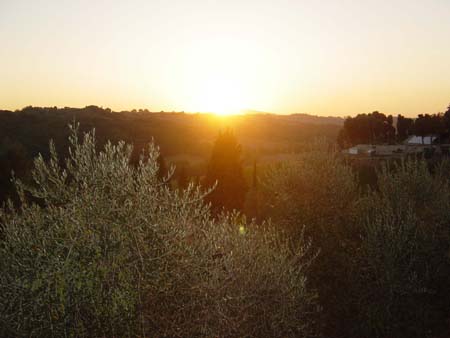
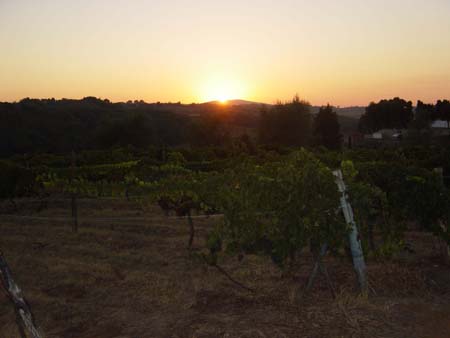
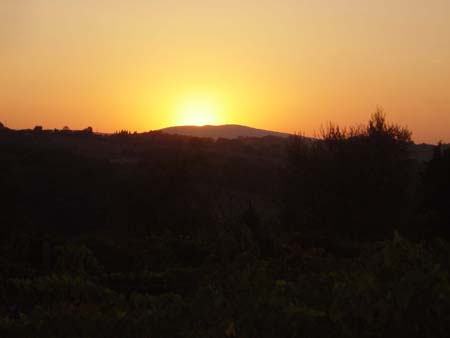
This evening, we enjoyed watching the sunset over the hills. It was a perfect and very peaceful evening. Tomorrow, we plan to return to Siena and explore its architecture and historical sites.
Distance Walked: 1.23 miles
